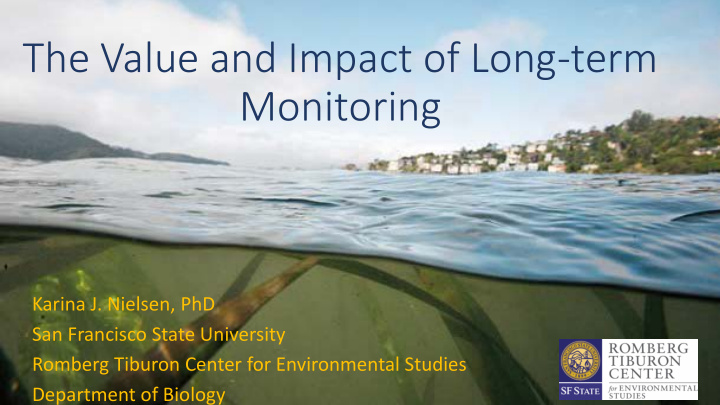



The Value and Impact of Long-term Monitoring Karina J. Nielsen, PhD San Francisco State University Romberg Tiburon Center for Environmental Studies Department of Biology
Decisions need to be made about important environmental issues • Decisions have consequences • Economy • Environment • Quality of life • Families
High quality, long-term monitoring supports evidence-based decision making • Reduces uncertainty • Increases forecasting capacity • Tracks impacts of policy, other changes • Enables adaptive management • Facilitates communication, engagement with broader audiences
Short-term studies are important, but not sufficient Atmospheric CO 2 330 • Seasonal cycle 325 CO 2 (ppm) 320 • Trend? 315 310 305 1958 1959 1960 Year
Inconsistent monitoring impedes understanding Atmospheric CO 2 • Seasonal cycle 410 390 • Trend CO 2 (ppm) 370 350 • Gaps? 330 310 290 1955 1965 1975 1985 1995 2005 2015 Year
High quality, long-term monitoring provides strong evidence Atmospheric CO 2 • Seasonal cycle 410 390 • Trend CO 2 (ppm) 370 350 • Persistent 330 • Convincing 310 290 1955 1965 1975 1985 1995 2005 2015 Year Source: R. F. Keeling, S. J. Walker, S. C. Piper and A. F. Bollenbacher Scripps CO2 Program (http://scrippsco2.ucsd.edu )
Value and purpose of long-term monitoring questioned, commitment to sustain was key • Funders • Scientific community http://scrippsco2.ucsd.edu/history_legacy/keeling_curve_lessons
Long-term ecological and environmental studies have high value and impact • Examples of long-term studies • Scientific value • Policy value • Importance, relevance for California https://data.globalchange.gov/report/nca3/chapter/coastal-zone/figure/coastal-ecosystem-services
San Francisco Estuary, delta smelt, multiple stressors Interagency Ecological Program (http://www.water.ca.gov/iep/) Consortium of state and federal agencies Since 1970’s Researchers: Wim Kimmerer, Peter Moyle, Larry Brown, John Durand, James Hobbs and others Institution: San Francisco State University, UC Davis, US Geological Survey and others
Consequences of water diversion flows on delta smelt, Endangered Species Act • Only some stressors have Entrainment loss calculation Evidence-based conceptual model potential to be managed • Entrainment loss calculations, different water diversion flows, water years • Critical evidence for USFWS 2008 ESA-mandated Biological Opinion • Importance evident in subsequent monitoring, analysis Kimmerer 2008 Moyle et al. 2016
Cosco Buscan oil spill, Natural Resource Damage Assessment (NRDA) Cosco Busan SF Bay Herring Biomass Oil Spill Herring Biomass and Spawning Surveys (https://www.wildlife.ca.gov/) California Department of Fish and Wildlife Since 1979 Historic herring NRDA Settlement Oiled shoreline spawning areas Researchers: John Incardona, Gary Cherr, Katharyn Boyer, and others Institutions: NOAA, UC Davis, San Francisco State University
Herring data, essential evidence for NRDA settlement, eelgrass restoration ongoing • 2007-08: spawn mortality was 14-29% • Historic spawning areas from surveys • Spawning biomass surveys • Oil spill overlap • Toxicity, mortality of spawn • 2008-09: Lowest spawning biomass recorded • 2009-10: Herring season closed • 2010-11: Spawning biomass rebounded, fishery re-opened
Sea otters recolonize estuaries Elkhorn Slough Sea Otter Research (https://www.werc.usgs.gov/) Data since 1965 (new partnership) Researchers: Brent Hughes, Ron Eby, Eric Van Dyke, Tim Tinker, Corina Marks, Kenneth Johnson, Kerstin Wasson and others Institutions: University of California-Santa Cruz, Elkhorn Slough National Estuarine Research Reserve, U.S. Geological Survey, CSU Monterey Bay, Monterey Bay Aquarium Research Institute
Sea otters benefit eelgrass, mitigating impacts of nutrient loading • Recovery of top predators results in trophic cascade • Eelgrass rebounds, despite increasing nutrient loading
Northern & Central California National Marine Sanctuaries, SF Bay Shipping Lanes Applied California Current Ecosystem Studies (http://accessoceans.org/) Since 2004 Ship traffic Humpback habitat use Researchers: Andrea Dransfield, Ellen Hines, Jaime Jahncke and others Institutions: San Francisco State University, Point Blue, Greater Farallones National Marine Sanctuary, Cordell Bank National Marine Sanctuary and others
Understanding the consequences of policy changes: new shipping lanes, endangered humpback whales Pre-2013 Post-2013 2013 - new shipping lanes (USCG) • 69% reduction in vessel traffic footprint within sanctuaries • 76% reduction in overlap with highly used habitat • Vessel traffic may be more concentrated
Long-term monitoring addresses something people need to know (Lindenmeyer & Likens 2009)
Attributes of useful & sustainable long-term monitoring programs are known • Purpose (question/hypothesis) • Data management & dissemination • Both basic AND applied purposes • Inclusive participation by scientific community, others • Integrity of time series is maintained • Management & governance structure • Consistency/quality of data collection • Rigorous funding structure • Adaptability • Educational component • Rigorous, detailed documentation (Hughes et al. 2017)
Stagnation of National Science Foundation funding threatens availability of long-term monitoring data • Existing programs more precarious • Fewer new programs being started (Hughes et al. 2017)
Long-term monitoring addresses coastal & ocean issues important to California Climate Change Fisheries Management Pollution Marine Protected Areas Network Emerging Issues
Recommend
More recommend